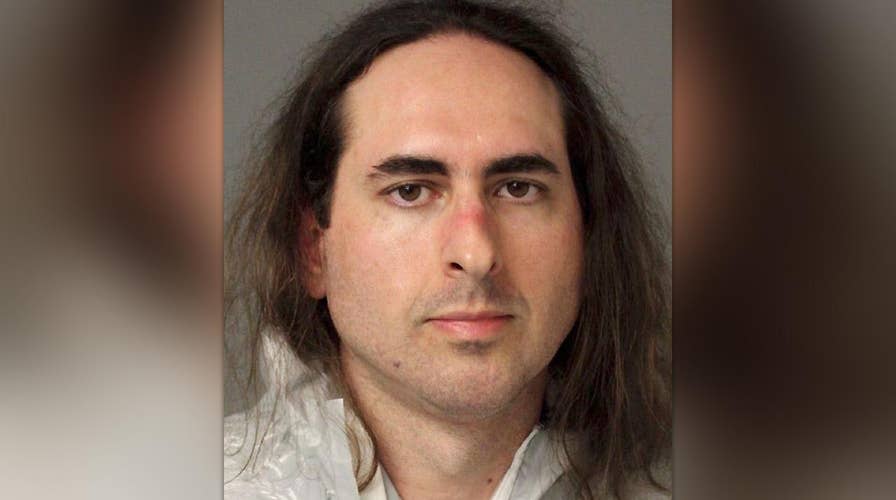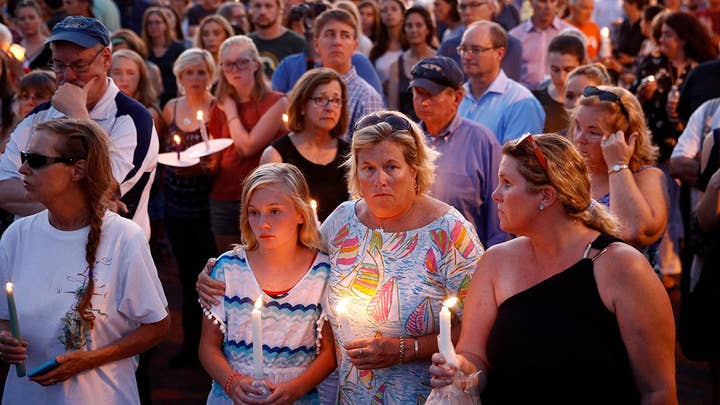New details emerge on suspected Annapolis newsroom gunman
38-year-old Jarrod Ramos charged with five counts of first-degree murder for attack on the Capital Gazette; Lea Gabrielle reports.
Police investigated Capital Gazette shooting suspect Jarrod Ramos in 2013, but concluded he was no threat, while the newspaper didn’t want to pursue a legal case against him for fear of putting “a stick in a beehive," a police report released Friday said.
Ramos, 38, was investigated that year after a barrage of Twitter messages aimed at Gazette staff members. But the paper didn't want to press charges or seek a restraining order for fear of inflaming the situation, the 2013 police report says.
"As of this writing the Capital will not pursue any charges," Detective Michael Praley wrote. "It was described as putting a stick in a beehive, which the Capital Newspaper representatives do not wish to do."
"As of this writing the Capital will not pursue any charges. It was described as putting a stick in a beehive, which the Capital Newspaper representatives do not wish to do."
Praley said in the report that he did not believe that Ramos "was a threat to employees" at the paper, noting that Ramos hadn't tried to enter the building and hadn't sent "direct, threatening correspondence."
This week Tom Marquardt, the paper's retired former publisher, said he talked with the newspaper's attorneys about seeking a restraining order in 2013, but didn't because he and others thought it could provoke Ramos into something worse.
"We decided to take the course of laying low," Marquardt said Friday.
"We decided to take the course of laying low."
Ramos reportedly had a longtime grudge against the newspaper, which authorities said culminated Thursday in one of the deadliest attacks on journalists in U.S. history. Ramos is accused of killing three editors, a reporter and a sales assistant.
The Laurel, Md., man had filed a defamation lawsuit against the paper in 2012 after it ran an article about him pleading guilty to harassing a woman who was his former high school classmate. A judge dismissed the case in 2014.
Afterward, Ramos allegedly posted angry, profanity-laced tweets about the paper, its reporters and editors, often using the hashtag #CapDeathWatch.
Ramos is also linked to a 2011 harassment case involving a former high school classmate, authorities said.
Brennan McCarthy, the lawyer who represented the former classmate, said Ramos’ harassment of her was malicious and that it was the “worst case of harassment and stalking I have ever encountered in my career,” according to USA Today.
Ramos’ alleged victim, who is not named in court documents, fled Maryland, with McCarthy adding, “I don’t think she had a choice. He’d have killed her.”
"This guy was the most dangerous person I've ever dealt with in the court system," McCarthy told the paper. "Because this guy was smart. He was not stupid … he knew how to walk the line" between frightening people and threats that could land him in jail.
"This guy was the most dangerous person I've ever dealt with in the court system. Because this guy was smart."
McCarthy told USA Today that he too became a target of Ramos’ rage, as he began harassing the lawyer’s sister and family. McCarthy constantly worried that Ramos might come after one of his 19 nieces and nephews, the report said.
"It was a like a silent threat hanging out there," McCarthy said. "That is even worse because there's no mechanism of law to stop this guy from doing something you just think he might do. The Capital was in the same boat. They knew how dangerous he was."
In 2015, Ramos allegedly tweeted that he would like to see the paper stop publishing, but “it would be nicer” to see two of its journalists “cease breathing.”
But Ramos’ online grudge seemed to disappear for a while until some new posts appeared just before the killings.
Investigators were reviewing his social media postings and searching his apartment.
A Twitter account believed to be his has now been suspended.
But one of the biggest unanswered questions is what set Ramos off after a two-year period of silence.
A transcript from a hearing in his defamation case showed that Ramos was particularly bothered that the newspaper article reported he said “f--- you, leave me alone” to the woman who accused him of harassment.
The woman said she hadn’t written him in months.
“That carries a clear implication that something is wrong inside my head, that I’m insane,” Ramos told the judge.
Ramos sent that same message on the day of the shootings on a Twitter feed he controlled.
“F--- you, leave me alone,” he wrote.
On the day of the shooting, McCarthy was not shocked when he discovered the news.
"The moment I heard there was a shooting at the Capital, I told my wife, 'That's Jarrod Ramos,'" McCarthy told the USA Today. "It did not surprise me in the least. The only question was where he would stop by first: My house or their office."
"The moment I heard there was a shooting at the Capital, I told my wife, 'That's Jarrod Ramos.'"
The Associated Press contributed to this report.

























